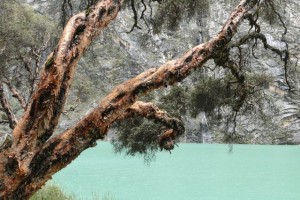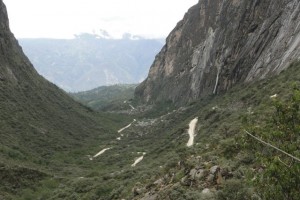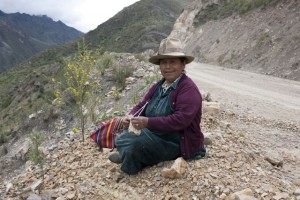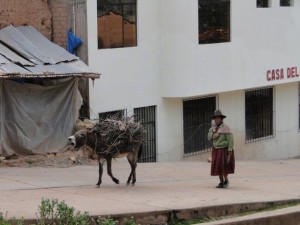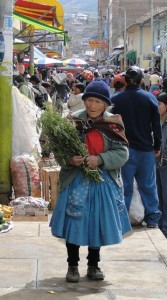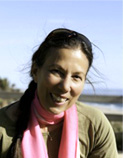It’s a long and winding road……Even though we’ve only been driving for 5 days, it seems like forever. And there’s nothing we needed as much as a rest day here in this lovely hotel in the village of Concepcion, 20 minutes north of Huancayo.
The only part of our plans that has come to fruition is that we did indeed drive north out of Lima on February 16. That we were able to do this took many miracles and much assistance from a gracious warehouse manager at the customs docks in Callao (Lima’s port), who faced down the placid, “who cares about you” stonewalling of our assigned custom’s broker as he held our car papers hostage for 4 hours. Triumphantly securing the last stamps on our carnet at 7pm, we retrieved Brunhilde from the farthest corner of the enormous port warehouse yard, where she sat huddled and covered with black grime. Hand-scribbled map in hand, we wove our way through Lima’s dark streets, doing pretty darn well until we got muddled around one too many ceremonial plazas. Was this 2 de Mayo? San Martin? And how could we tell? When I asked a policeman for directions, he and his troops jumped in their patrol car and gave us a full-sirens, flashing lights escort to our hotel. From that moment on, we’ve thought quite highly of Peru’s police, except for one unfortunate encounter the next morning.
Like most every city, Lima reserves its ugliest, poorest neighborhoods for its outskirts, through which we wound for an hour and a half until we’d finally left all traces of Lima behind. As we picked up speed on the empty highway, Bernard suddenly leaned forward, peered sharply into the rear view mirror, yelped “Oh my god!” and veered to the side of the road. Scrambling out of the car, we looked up to confirm that, indeed, our roof tent had done its thing, and popped up while we were driving. Since it wasn’t even 1pm we agreed it was too early to stop for the night. And who wants to sleep on the highway anyway. Bernard clambered to the roof and we stuffed the flapping innards back where they belonged.
Back on the road, I twisted off the cap of a fresh bottle of mineral water for a bit of refreshment. The geyser of bubbly water that drenched us was a moist lesson that, in future, I’d better check the label of any mineral water I buy to make sure it’s the flat kind that’s not bottled under pressure. Now covered with highway dust AND water, we noticed a policeman ahead and decided to ask him whether we were definitely on the right road. As we slowed to a halt next to him, it dawned on me that his wave motioning us over meant that HE wanted US to pull over, not that WE were choosing to pull over. Sure enough he politely asked for Bernard’s driver license and our car registration. Politely explaining we’d been speeding: 77km in a 60km zone, he then politely waved his booklet of fines at us and politely informed us that the fine for this infraction would be about $130. However, in consideration of the fact that we hadn’t been speeding horribly, and that we were just starting our trip in Peru, he would allow us to pay half that amount directly to him rather than requiring that we go to a nearby town while he kept Bernard’s driver’s license securely on his clipboard. His very suaveness earned him what essentially was a $70 tip that surely went straight into the pocket of his skin-tight uniform as soon as we were gone. And we decided then and there to make several color copies of Bernard’s driver’s license, so that any officer desirous of holding onto it could keep it forever, could frame it for all we cared, without our paying any sort of “fine.”
On this first day, we made a brief detour off the Panamericana to see the excavated site of Caral, reputed by some to be the oldest city in Peru. Estimated at 2000B.C., this brown collapsed heap of stones at the base of the desert-y Cordillera Negra didn’t inspire us. But then, if I were 4000 years old, I wouldn’t be looking my best either. The long walk to and from the ruins necessitated lunch and a placard outside a village hut offered our only option. Ducking under the low doorway, I surveyed the premises. Pale blue walls, concrete floor, 3 tables, one already occupied. I was pointed over to one right next to what I assumed was a latrine. In a moment of great personal decisiveness, I took the one next to it instead. Not understanding what was printed on the slate menu board, I figured an inspection of the kitchen was in order. There I found a bowl filled with slabs of raw beef black with flies, a tub of chicken broth with spaghetti, and a bubbling thick beige sludge with chunks of something that could be ladled over rice. I’ll let you guess what we chose and will assure you that what we ate did not seek revenge on us later.
From Caral we pushed north and east, heading for Huaraz, which is in the heart of the Cordillera Blanca. The CB is the highest range in the world apart from the Himalaya, with 34 peaks nearly 20,000 feet high. For anyone who’s read Joe Simpson’s Touching the Void, this is the area where he was climbing. The mountains are magnificent here, and the villages in the valley are strung together by the cinnamon-colored torrent of the Rio Santo. Eight hours after leaving Lima, we made it to Huaraz. Though it was 9pm the day was not yet done with us.
Returning to our hotel room after dinner, I unlocked the door and walked in. Instead of Bernard being right behind me, though, I heard a loud crash followed by a muffled exclamation. I turned around. No Bernard. Alarmed, I returned to the alcove at the room’s entrance and there I found him in a heap. We can only conjecture how this happened and the most unmortifying explanation is that his sneaker sole hooked into the carpet, sending him tripping sideways, such that he slammed into the door dividing our room from the neighboring one, rebounded off, crashed into the armoir next to it, and ended that little ballet in a dazed pile of limbs on the floor. Bernard is the sort who instantly leaps up after any fall, as though to say “I’m fine, nothing wrong here,” even if he’s broken a bone. Now though, it took him a good few minutes to recover some sense of equilibrium. No particular damage was done, but I did have to give him an assist to get off the floor and and apply large quantities of hugs before we both felt that he was OK.
In the Huaraz area, the farm land is striped with the magenta and white of potato blossoms, and sows on a leash graze with their piglets by the roadside. Enormous bromeliads impersonating a blue agave shoot 20-foot high blossom spikes into the air and purple lupine flower along the roadside. Over this tower the famous peaks of Huascaran, Alpamayo and others. It is in this valley that the 18000 villagers of Yungay were buried alive when, in 1970, a magnitude 8 earthquake (think Port-au-Prince) shook Huascaran hard enough to dislodge a monstrous chunk of ice from the face (100s of meters in size and 1000s of tons). When that ice block crashed into the ground it liquified and created the mother of all mudslides, smothering the hamlet of Yungay in minutes. All that remains of the original village are the tops of 4 palm trees, the facade of the church, and 200 children, made instant orphans when the landslide tore through the park where their parents were chatting, somehow sparing the field next to it where the kids attended a soccer tournament. A new village has grown near the site of the buried one, and as we drove the dirt tracks up to Lago Llanganuco we most assuredly were driving over that very same landslide.
Since Huaraz we’ve gotten pretty remote, not that we intended to. First, we learned swiftly that the driving in Peru would be so slow and our progress, mileage-wise, so modest, that we couldn’t hope to go further north than Huaraz and still get back down to Lake Titicaca and into Bolivia. We made the sad decision to cancel our planned inspection of the purportedly magnificent, and definitely little-visited, ruins of Sicán and Sipán. Instead we’ve headed east on what the map indicated should be nearly top-class roads. And thus we learned that our map of Peru has nothing to do with what’s on the ground. Roads that are classified as paved are rocky, bumpy dirt tracks. Roads that are supposed to be unimproved are freshly graded feats of engineering. It’s impossible to know what to expect, except for the fact that it’s taking a loooooong time to get anywhere. We’ve driven over and around myriad little mud slides, which I take as cordial indications that the land around is only happy when settling somewhere else.
The roads we’ve taken have woven through many tiny villages, where people are always willing to help with directions. What I’m finding out, though, is that the question I ask about where to go, isn’t the question they’re answering. I simplify my directional question to the most basic. “Is Llantotamba this way?” The answer I get, such as “Yes, straight ahead” or “Keep going on this road” is perfectly acceptable. No reason to question it. At least until we turn the corner 50 yards ahead and there’s a fork in the road which no one mentioned. If we’re lucky, someone will be sitting at that fork and we’ll stop again and ask the same question. i don’t yet understand why I can’t get a response like “Yes, and up ahead there’s a fork where you stay left.” I’m working on coming up with a better question to ask so I get better information.
Still, we haven’t gotten lost yet. And we’ve had some wonderfully unexpected experiences. I’ve shared a chocolate bar with a Quechua granny–purple skirt, teal blouse, brown felt high-peaked hat– who was sitting by the roadside knitting. She’d picked the perfect spot, along a particularly magnificent set of alpine curves, high above the valley of Chavin. Like most of the older Quechua women we’ve seen, she would have been perhaps 4 1/2 feet tall if she’d stood up.
After Huaraz, we spent the night in the miniscule hamlet of Puntó where we were flabbergasted to discover a new. rudimentary guesthouse had been built, largesse from Antamina, one of the major mining companies extracting the precious minerals that form 50% of Peru’s export economy. In Puntó, perched on the ridge of a thoroughly steep hillside, donkeys carrying bundles of firewood brayed their disapproval that life should require climbing up such vertical slopes and pigs left their droppings as little time bombs which we strove to avoid on our walk to dinner after dark. Our dinner of potatoes w/spaghetti, whose pink sheen denoted barely a passing acquaintance with tomato sauce, was in the thatched-roof second floor of the cook’s home, also the location of one of the village’s few TVs on which a soccer match between Venezuela and Peru was playing. They even scrounged a bottle of Peruvian red wine for Bernard, which turned out to approximate grapejuice with 11% alcohol. We happily poured a round for everyone else in the room, rather than drink it ourselves. The fleas I’ve been doing battle with every day were especially tenacious in Punto, resulting in myriad itchy spots, including one the size of a flapjack on my butt.
Serenaded by the village dogs, we quit Punto before dawn and saw sunrise at a high mountain pass. Our cold fingers clutched egg and cheese sandwiches as we watched shepherds move their communal flocks to fresh pasture. Tremendously wild and beautiful alpine scenery followed, as we plunged down extraordinarily steep but well-built dirt roads, climbed up through red gorges and commented on the fact that every house in every village had a new tin roof, also the largess of Antamina. Mid-day we inched our way through a dense crowd of mountain villagers, gathered in the town of Acopampa to collect their monthly $35 stipend from the government. For an hour we waded through this sea of color, sampled a tamale-like offering made of rice, talked up the municipal guard who explained the stipend is in exchange for villagers ensuring better nutrition, health visits and education for their children. Somehow I felt I wasn’t getting the whole story from him, but he was called off to check identity cards and I couldn’t learn more.
Day’s end for us was the hideous mining town of Cerro de Pasco, where a grimy drizzle cast a pall over an already unappealing situation: only one room that we could find and that without heat at an altitude of over 17,000 feet (4380 meters). So tired were we after the thousands of curves and potholes negotiated that day that we didn’t even notice what’s possibly the world’s largest open pit mine right there in front of us. The gnawing headache that visited me during the night was par for the course, though being squashed under at least 50 pounds of blankets didn’t help.
It was a great relief to be here in the pretty Mantaro Valley of Junin district, which is much rejuvenated since the horrid strife of the Sendero Luminoso (Shining Path guerillas) in the 1980s and 90s, during which they say more than 69,000 villagers were caught in the cross fire between guerillas and army. Brunhilde got a well-deserved wash. She’s the perfect vehicle for this sort of trip and we’re both pleased with her robust fortitude. I’m just now back from visiting a 300-year-old Franciscan monastery, where many of the avidly proselytizing and exploring priests of the 16th century were originally based. Besides marveling at the illuminated manuscripts in their library, we gagged happily at the extraordinary display of bugs, birds and animals they collected (and preserved….somewhat) during their evangelical missions into the Amazon.
As we crossed the village square next to the cloister I saw 8 horses and a host of villagers drinking beer. A competition between Paso Fino horses was just getting underway, with the crowd’s energy (and the horses’ excitement) egged on by a village band. We watched for a bit, shared a beer and the mayor invited Bernardo to say hello to the crowd.
Oh, one amazing coincidence I must share: the manager at our inn here has spent much time talking with us, since we’re the only guests. So I’ve found out that he is from the Carhuaz, the village next to Yungay. He was 15 when the landslide buried the village, felt, heard and saw the whole thing. He told us in detail about watching the mountains shake with the earthquake, hearing the unexplainable roar of the landslide and of the bitter cold from dust so thick it blocked all light and warmth from the sun, wrapping the valley in a cloak of pitch dark for 3 days. An incredible and heart-rending story.
Tomorrow morning we continue on to Ayacucho where we hope our luck in stumbling onto unusual things will continue. Today Bernard, unprompted by me, said his first word in Spanish: siete (seven). I was so proud.
-Dina










